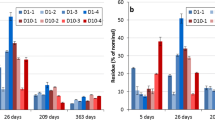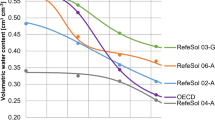Abstract
Soil organisms play a crucial role in the terrestrial ecosystem. Plant protection products (PPPs) are known to affect soil organisms and might have negative impacts on soil functions influenced by these organisms. Little research has been performed to date on the impact of PPPs on tropical soil ecosystems. Therefore, in this study it was investigated whether the effects of the fungicide benomyl (chosen as a model substance) differ between tropical and temperate regions and whether data generated under temperate conditions can be used for the Environmental Risk Assessment (ERA) in tropical regions. The effect of benomyl on earthworms was evaluated in acute and chronic laboratory tests modified for tropical conditions. These tests were performed at two temperatures (20°C and 28°C) and with two strains (temperate and tropical) of the compost worm Eisenia fetida. The fungicide was spiked in two natural and two artificial soils. In addition to the organization for economic cooperation and development (OECD) artificial soil, a tropical artificial soil (TAS), containing a tropical fern product (xaxim) instead of peat, was developed in this study. The results from the laboratory tests and a literature review showed that the effects of benomyl were, on average, lower under tropical conditions (LC50: 450–630 mg active ingredient (a.i.)/kg; EC50: 0.8–12.9 mg a.i./kg) than under temperate conditions (LC50: 61–67 mg a.i./kg; EC50: 1.0–1.6 mg a.i./kg) by a maximum factor of 10.3 (acute tests) and 12.9 (chronic tests). This result might be caused by an increased degradation of benomyl, and/or its first metabolite carbendazim, at higher temperatures, but a different sensitivity of the two worm strains cannot be ruled out. Despite the lower toxicity under tropical conditions and assuming comparable application rates, a preliminary assessment confirms the risk of benomyl to soil invertebrates under both conditions.








Similar content being viewed by others

References
ANVISA (2001) Agência Nacional de Vigilância Sanitária. Portaria Conjunta n° 1: Procede à reavaliação toxicológica e ambiental dos produtos técnicos e formulados a base de benomil e carbendazim. Diário Oficial da União de 26 de outubro de 2001. Brasília, Brazil
ANVISA (2003) Agência Nacional de Vigilância Sanitária. Resolução RE n° 165: Determina a publicação do “Índice das monografias dos ingredientes ativos de agrotóxicos, domissanitários e preservantes de madeira”, cujo emprego encontra-se autorizado conforme descrito na monografia. Diário Oficial da União de 02 de setembro de 2003. Brasília, Brazil
Bharathi C, Subba Rao BVSSR (1984) Toxicity of Phosphamidon to the common South Indian earthworm Lampeto mauritii. Bull Environ Contam Toxicol 32:295–300
Chapman PF, Crane M, Wiles JA, Noppert F, McIndoe EC (eds.) (1996) Asking the right questions: Ecotoxicology and statistics. SETAC Press, Brussels
Cook AG, Critchley BR, Critchley U, Perfect TJ, Yealdon R (1980) Effects of cultivation and DDT on earthworm activity in a forest soil in the sub-humid tropics. J Appl Ecol 17:21–29
EMBRAPA (1997). Centro Nacional de Pesquisa de Solos. Manual de métodos de análises de solo, 2nd ed. EMBRAPA, Rio de Janeiro
ESG (1999) The relative toxicity of four pesticides to two species of earthworm in artificial and natural soils. Freshwater and Pesticide Section, Guidelines Division, Eco-Health Branch Environment Canada, Ottawa, Ontario
ESG (2002) Assessment of the biological test methods for terrestrial plants and soil invertebrates: pesticides. Method Development and Applications Section, Environmental Technology Centre, Environment Canada, Ottawa, Ontario
EU (1991) European Union. Council directive concerning the placing of plant protection products on the market. No. 91/414/EEC. European Union, Brussels
EU (2002) European Union. Commission decision concerning the non-inclusion of benomyl in Annex I to Council Directive 91/414/EEC and the withdrawal of authorizations for plant protection products containing this active substance (2002/928/EC). Off J Eur Union, L322:53–54
FAO (1990) Food and Agriculture Organisation of the United Nations. Soil map of the world—revised legend. World Soil Resources Report 60, FAO. Rome
Garcia MV (2004). Effects of pesticides on soil fauna: development of ecotoxicological test methods for tropical regions. Ecology and Development Series No. 19. Zentrum für Entwicklungsforschung, University of Bonn, Germany
Hans RK, Gupta RC, Beg MU (1990) Toxicity assessment of four insecticides to earthworm, Pheretima posthuma. Environ Contam Toxicol 45:358–364
Haque A, Ebing W (1983) Toxicity determination of pesticides to earthworms in the soil substrate. Zeitschr r Pflanzenkrankh Pflanzensch 90:395–408
Heimbach F (1984) Correlations between three methods for determining the toxicity of chemicals to earthworms. Pesticide Sci 15:605–611
Heimbach F (1985) Comparison of laboratory methods for the assessment of the hazard of chemicals to earthworms. Zeitschr Pflanzenkrankh Pflanzensch 92:186–193
Helling B, Reinecke SA, Reinecke AJ (2000) Effects of the fungicide copper oxychloride on the growth and reproduction of Eisenia fetida (Oligochaeta). Ecotoxicol Environ Safety 46:108–116
Hund-Rinke K, Achazi R, Römbke J, Warnecke D (2003) Avoidance test with Eisenia fetida as an indicator for the habitat function of soils: Results of a laboratory comparison test. J Soils Sediments 3:7–12
ISO (1994) International Organization for Standardization. ISO-10390: Soil quality–Determination of pH. ISO, Geneva
ISO (1998a) International Organization for Standardization. ISO-11268-2: Soil quality–Effects of pollutants on earth-worms (Eisenia fetida)—Part 2: Method for the determination of effects on reproduction. ISO, Geneva
ISO (1998b) International Organization for Standardization. ISO-11272: Soil quality–Determination of dry bulk density. ISO, Geneva
ISO (1998c) International Organization for Standardization. ISO-11277: Soil quality–Determination of particle size distribution in mineral soil material—Method by sieving and sedimentation. ISO, Geneva
Klein W (1989) Mobility of environmental chemicals, including abiotic degradation. In: Bordeau P, Haines JA, Klein W, Krishna Murti CR (eds) Ecotoxicology and climate. SCOPE 38. Wiley, Chichester, pp 65–78
Knäpper CFU (1981) The eartholigochaetes as bioindicators of cultivated soils treated with phosphorated and chlorated insecticides. Estudos Leopoldenses Univ do Vale do Rio dos Sinos 17:73–74
Kula C (1998) Endpoints in laboratory testing with earthworms: experience with regard to regulatory decisions for plant protection products. In: Sheppard S, Bembridge J, Holmstrup M, Posthuma L (eds) Advances in earthworm ecotoxicology. SETAC Press, Pensacola, FL, pp 3–14
Laabs V, Amelung W, Pinto A, Altstaedt A, Zech W (2000) Leaching and degradation of corn and soybean pesticides in an Oxisol of the Brazilian Cerrados. Chemosphere 41:1441–1449
Løkke H, Van Gestel CAM (eds) (1998) Handbook of soil invertebrate toxicity tests. Wiley, Chichester
Maroni M, Auteri D, Grasso P, Alberio P, Redolfi E, Azimonti G, Giarei C, Visentin S, Cavallaro P, Zaghi C (2002) Statistical evaluation of available ecotoxicological data on plant protection products and their metabolites. Final Rreport for the European Commission No. B1-3330/2001216. Luxembourg
Meister R, Van den Brink PJ (2000) The analysis of laboratory toxicity experiments. In: Sparks T (ed) Statistics in ecotoxicology. Wiley, Chichester, pp 99–118
OECD (1984) Organisation for Economic Co-operation and Development: Guideline for testing of chemicals No. 207. Earthworm acute toxicity test. OECD, Paris
OECD (2004) Organization of Economic Cooperation and Development Guideline for testing of chemicals No. 222. Earthworm reproduction test (Eisenia fetida/andrei). OECD, Paris
Paraiba LC, Cerdeira AL, Silva EF, Martins JS, Coutinho HLC (2003) Evaluation of soil temperature effect on herbicide leaching potential into groundwater in the Brazilian Cerrado. Chemosphere 53:1087–1095
Schinkel K (1985) Prüfung der Beständigkeit von Pflanzenschutzmitteln im Boden im Rahmen des Zulassungsverfahrens. Berichte Landwirtschaft 198:9–20
Senapati BK, Biswal J, Sahu SK, Pani SC (1991) Impact of malathion on Drawida willsi, a dominant earthworm in Indian rice fields. Pedobiologia 35:117–128
US EPA (2002) Reregistration Eligibility Decision (RED): Benomyl. United States Environmental Protection Agency, Office of Prevention, Pesticides, and Toxic Substances, Washington, DC
Van Gestel CAM (1992) Validation of earthworm toxicity tests by comparison with field studies: a review of benomyl, carbendazim, carbofuran, and carbaryl. Ecotoxicol Environ Safety 23:221–236
Van Gestel CAM, Dirven-Van Breemen EM, Baerselman R, Emans HJB, Janssen JAM, Postuma L, Van Vliet PJM (1992) Comparison of sublethal and lethal criteria for nine different chemicals in standardized toxicity tests using the earthworm Eisenia fetida. Ecotoxicol Environ Safety 23:206–230
Van Gestel CAM, Zaal J, Van Breemen EM (1995) Comparison of two test methods for determining the effects of pesticides on earthworm reproduction. Acta Zool Fennica 196:278–283
Verma A, Pillai MKK (1991) Bioavailability of soil-bound residues of DDT and HCH to earthworms. Curr Sci 61:840–843
Vink K, Van Straalen NM (1999) Effects of benomyl and diazinon on isopod-mediated leaf litter decomposition in microcosms. Pedobiologia 43:345–359
Viswanathan PN, Krishna Murti CR (1989) Effects of temperature and humidity on ecotoxicology of chemicals. In: Bordeau P, Haines JA, Klein W, Krishna Murti CR (eds) Ecotoxicology and climate. SCOPE 38. Wiley, Chichester, pp 139–154
WHO (1993) Environmental Health Criteria 148: Benomyl. World Health Organization, Geneva
WHO/FAO (1994) Joint Meeting on Pesticides Residues (JMPR). Report: Carbendazim (072). World Health Organization and Food and Agriculture Organisation, Geneva
Acknowledgments
The work presented here is sponsored by the National Council for Scientific and Technological Development (CNPq; Brazil) and by the Federal Ministry of Education and Research (BMBF; Germany).
Author information
Authors and Affiliations
Corresponding author
Rights and permissions
About this article
Cite this article
Römbke, J., Garcia, M.V. & Scheffczyk, A. Effects of the Fungicide Benomyl on Earthworms in Laboratory Tests Under Tropical and Temperate Conditions. Arch Environ Contam Toxicol 53, 590–598 (2007). https://doi.org/10.1007/s00244-006-0219-8
Received:
Accepted:
Published:
Issue Date:
DOI: https://doi.org/10.1007/s00244-006-0219-8



